Evaluating Coca-Cola's Marketing Strategy: Objectives and Analysis
VerifiedAdded on 2023/06/15
|13
|3543
|334
Essay
AI Summary
This essay provides a critical analysis of Coca-Cola's strategic marketing management, examining its role in achieving organizational objectives and maintaining its market position. It delves into the company's corporate objectives, marketing strategies, and the tools and techniques used for situation analysis, including Porter's Five Forces, PEST analysis, and SWOT analysis. The essay evaluates Coca-Cola's current marketing strategy, highlighting its strengths, weaknesses, opportunities, and threats, while also considering the impact of external factors such as political, economic, social, and technological influences. The analysis emphasizes the importance of adapting marketing strategies to meet evolving market needs and consumer demands to sustain growth and profitability in the competitive non-alcoholic beverage industry. Desklib offers a platform to explore similar assignments and study resources for students.
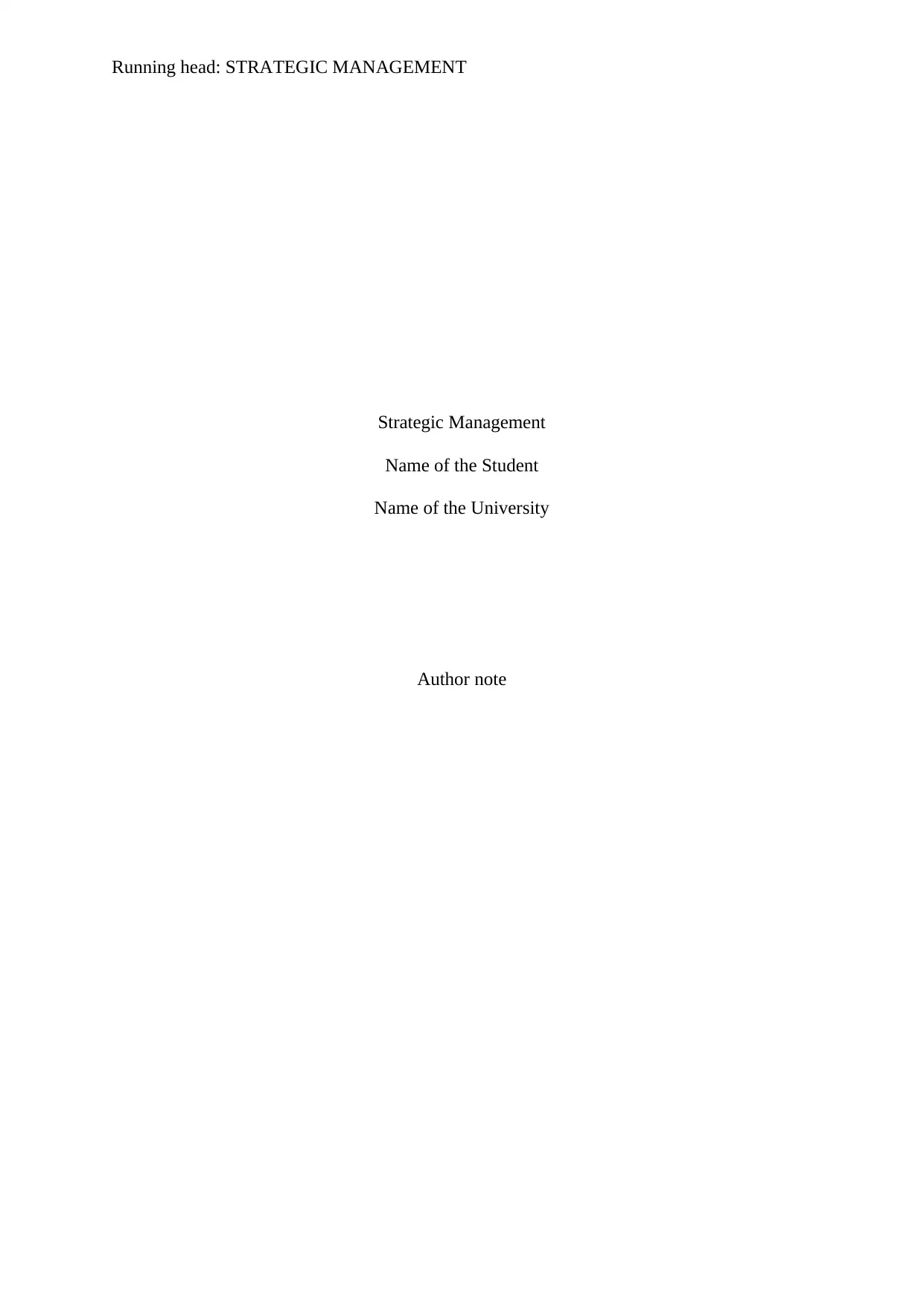
Running head: STRATEGIC MANAGEMENT
Strategic Management
Name of the Student
Name of the University
Author note
Strategic Management
Name of the Student
Name of the University
Author note
Paraphrase This Document
Need a fresh take? Get an instant paraphrase of this document with our AI Paraphraser
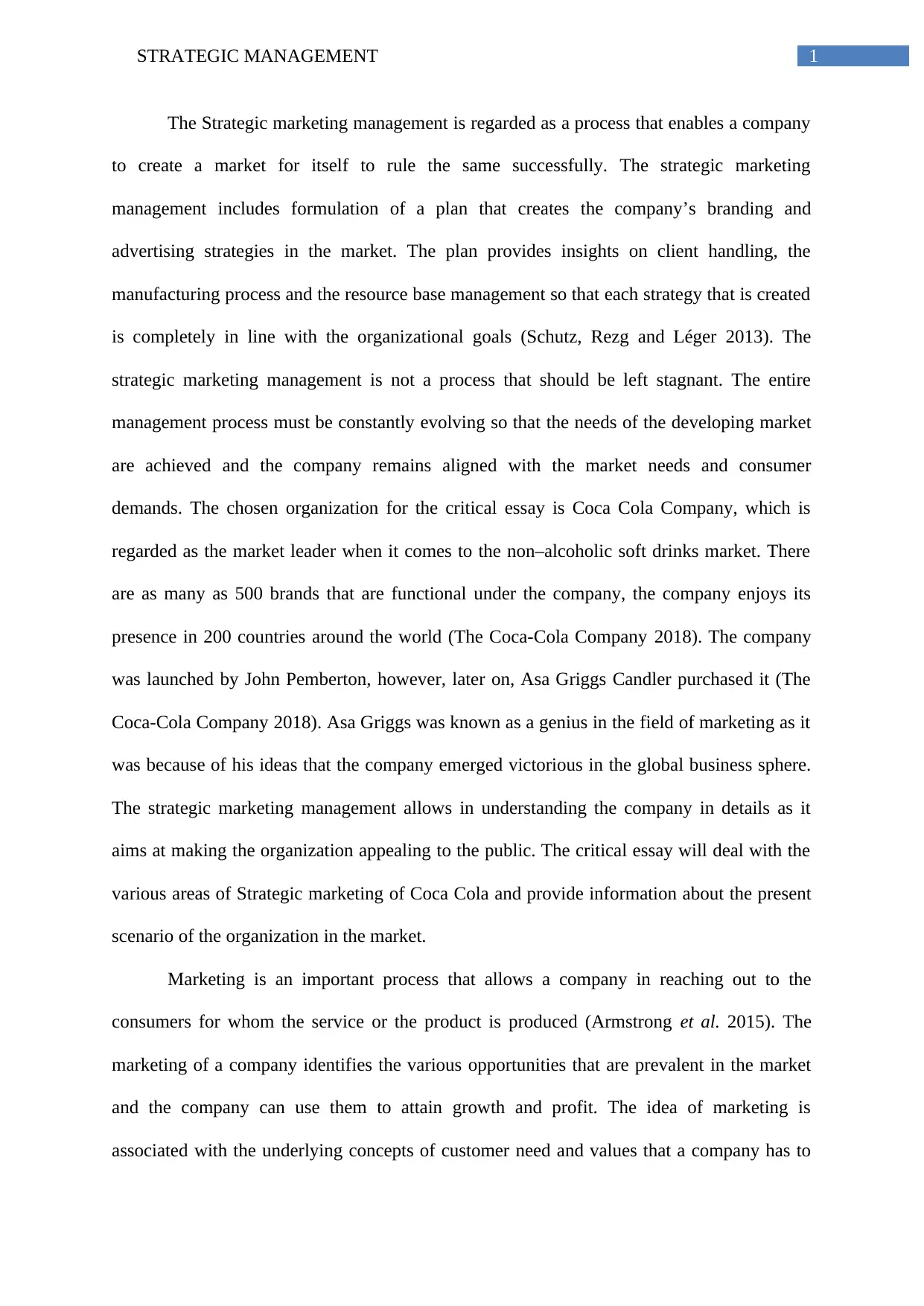
1STRATEGIC MANAGEMENT
The Strategic marketing management is regarded as a process that enables a company
to create a market for itself to rule the same successfully. The strategic marketing
management includes formulation of a plan that creates the company’s branding and
advertising strategies in the market. The plan provides insights on client handling, the
manufacturing process and the resource base management so that each strategy that is created
is completely in line with the organizational goals (Schutz, Rezg and Léger 2013). The
strategic marketing management is not a process that should be left stagnant. The entire
management process must be constantly evolving so that the needs of the developing market
are achieved and the company remains aligned with the market needs and consumer
demands. The chosen organization for the critical essay is Coca Cola Company, which is
regarded as the market leader when it comes to the non–alcoholic soft drinks market. There
are as many as 500 brands that are functional under the company, the company enjoys its
presence in 200 countries around the world (The Coca-Cola Company 2018). The company
was launched by John Pemberton, however, later on, Asa Griggs Candler purchased it (The
Coca-Cola Company 2018). Asa Griggs was known as a genius in the field of marketing as it
was because of his ideas that the company emerged victorious in the global business sphere.
The strategic marketing management allows in understanding the company in details as it
aims at making the organization appealing to the public. The critical essay will deal with the
various areas of Strategic marketing of Coca Cola and provide information about the present
scenario of the organization in the market.
Marketing is an important process that allows a company in reaching out to the
consumers for whom the service or the product is produced (Armstrong et al. 2015). The
marketing of a company identifies the various opportunities that are prevalent in the market
and the company can use them to attain growth and profit. The idea of marketing is
associated with the underlying concepts of customer need and values that a company has to
The Strategic marketing management is regarded as a process that enables a company
to create a market for itself to rule the same successfully. The strategic marketing
management includes formulation of a plan that creates the company’s branding and
advertising strategies in the market. The plan provides insights on client handling, the
manufacturing process and the resource base management so that each strategy that is created
is completely in line with the organizational goals (Schutz, Rezg and Léger 2013). The
strategic marketing management is not a process that should be left stagnant. The entire
management process must be constantly evolving so that the needs of the developing market
are achieved and the company remains aligned with the market needs and consumer
demands. The chosen organization for the critical essay is Coca Cola Company, which is
regarded as the market leader when it comes to the non–alcoholic soft drinks market. There
are as many as 500 brands that are functional under the company, the company enjoys its
presence in 200 countries around the world (The Coca-Cola Company 2018). The company
was launched by John Pemberton, however, later on, Asa Griggs Candler purchased it (The
Coca-Cola Company 2018). Asa Griggs was known as a genius in the field of marketing as it
was because of his ideas that the company emerged victorious in the global business sphere.
The strategic marketing management allows in understanding the company in details as it
aims at making the organization appealing to the public. The critical essay will deal with the
various areas of Strategic marketing of Coca Cola and provide information about the present
scenario of the organization in the market.
Marketing is an important process that allows a company in reaching out to the
consumers for whom the service or the product is produced (Armstrong et al. 2015). The
marketing of a company identifies the various opportunities that are prevalent in the market
and the company can use them to attain growth and profit. The idea of marketing is
associated with the underlying concepts of customer need and values that a company has to
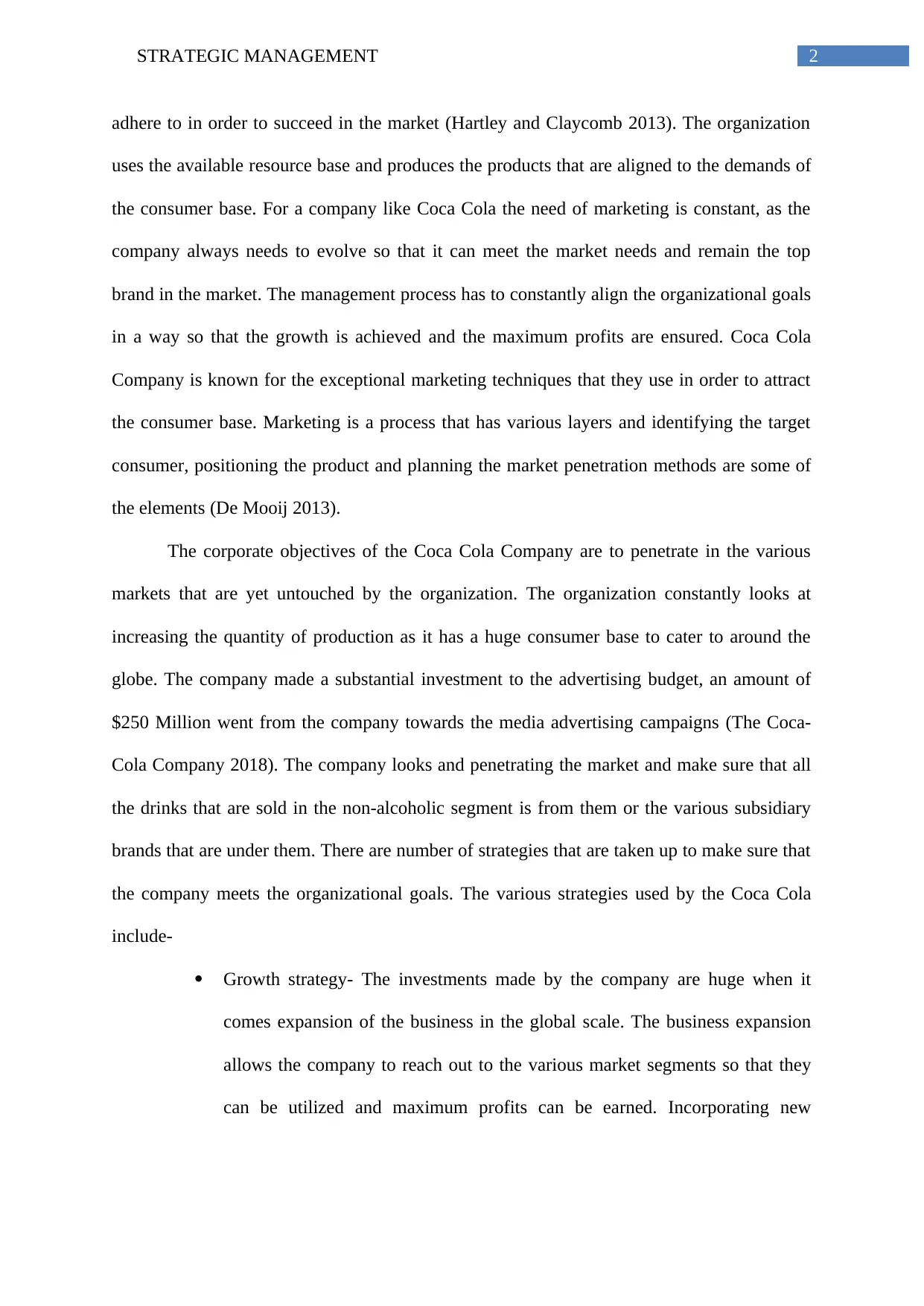
2STRATEGIC MANAGEMENT
adhere to in order to succeed in the market (Hartley and Claycomb 2013). The organization
uses the available resource base and produces the products that are aligned to the demands of
the consumer base. For a company like Coca Cola the need of marketing is constant, as the
company always needs to evolve so that it can meet the market needs and remain the top
brand in the market. The management process has to constantly align the organizational goals
in a way so that the growth is achieved and the maximum profits are ensured. Coca Cola
Company is known for the exceptional marketing techniques that they use in order to attract
the consumer base. Marketing is a process that has various layers and identifying the target
consumer, positioning the product and planning the market penetration methods are some of
the elements (De Mooij 2013).
The corporate objectives of the Coca Cola Company are to penetrate in the various
markets that are yet untouched by the organization. The organization constantly looks at
increasing the quantity of production as it has a huge consumer base to cater to around the
globe. The company made a substantial investment to the advertising budget, an amount of
$250 Million went from the company towards the media advertising campaigns (The Coca-
Cola Company 2018). The company looks and penetrating the market and make sure that all
the drinks that are sold in the non-alcoholic segment is from them or the various subsidiary
brands that are under them. There are number of strategies that are taken up to make sure that
the company meets the organizational goals. The various strategies used by the Coca Cola
include-
Growth strategy- The investments made by the company are huge when it
comes expansion of the business in the global scale. The business expansion
allows the company to reach out to the various market segments so that they
can be utilized and maximum profits can be earned. Incorporating new
adhere to in order to succeed in the market (Hartley and Claycomb 2013). The organization
uses the available resource base and produces the products that are aligned to the demands of
the consumer base. For a company like Coca Cola the need of marketing is constant, as the
company always needs to evolve so that it can meet the market needs and remain the top
brand in the market. The management process has to constantly align the organizational goals
in a way so that the growth is achieved and the maximum profits are ensured. Coca Cola
Company is known for the exceptional marketing techniques that they use in order to attract
the consumer base. Marketing is a process that has various layers and identifying the target
consumer, positioning the product and planning the market penetration methods are some of
the elements (De Mooij 2013).
The corporate objectives of the Coca Cola Company are to penetrate in the various
markets that are yet untouched by the organization. The organization constantly looks at
increasing the quantity of production as it has a huge consumer base to cater to around the
globe. The company made a substantial investment to the advertising budget, an amount of
$250 Million went from the company towards the media advertising campaigns (The Coca-
Cola Company 2018). The company looks and penetrating the market and make sure that all
the drinks that are sold in the non-alcoholic segment is from them or the various subsidiary
brands that are under them. There are number of strategies that are taken up to make sure that
the company meets the organizational goals. The various strategies used by the Coca Cola
include-
Growth strategy- The investments made by the company are huge when it
comes expansion of the business in the global scale. The business expansion
allows the company to reach out to the various market segments so that they
can be utilized and maximum profits can be earned. Incorporating new
⊘ This is a preview!⊘
Do you want full access?
Subscribe today to unlock all pages.

Trusted by 1+ million students worldwide
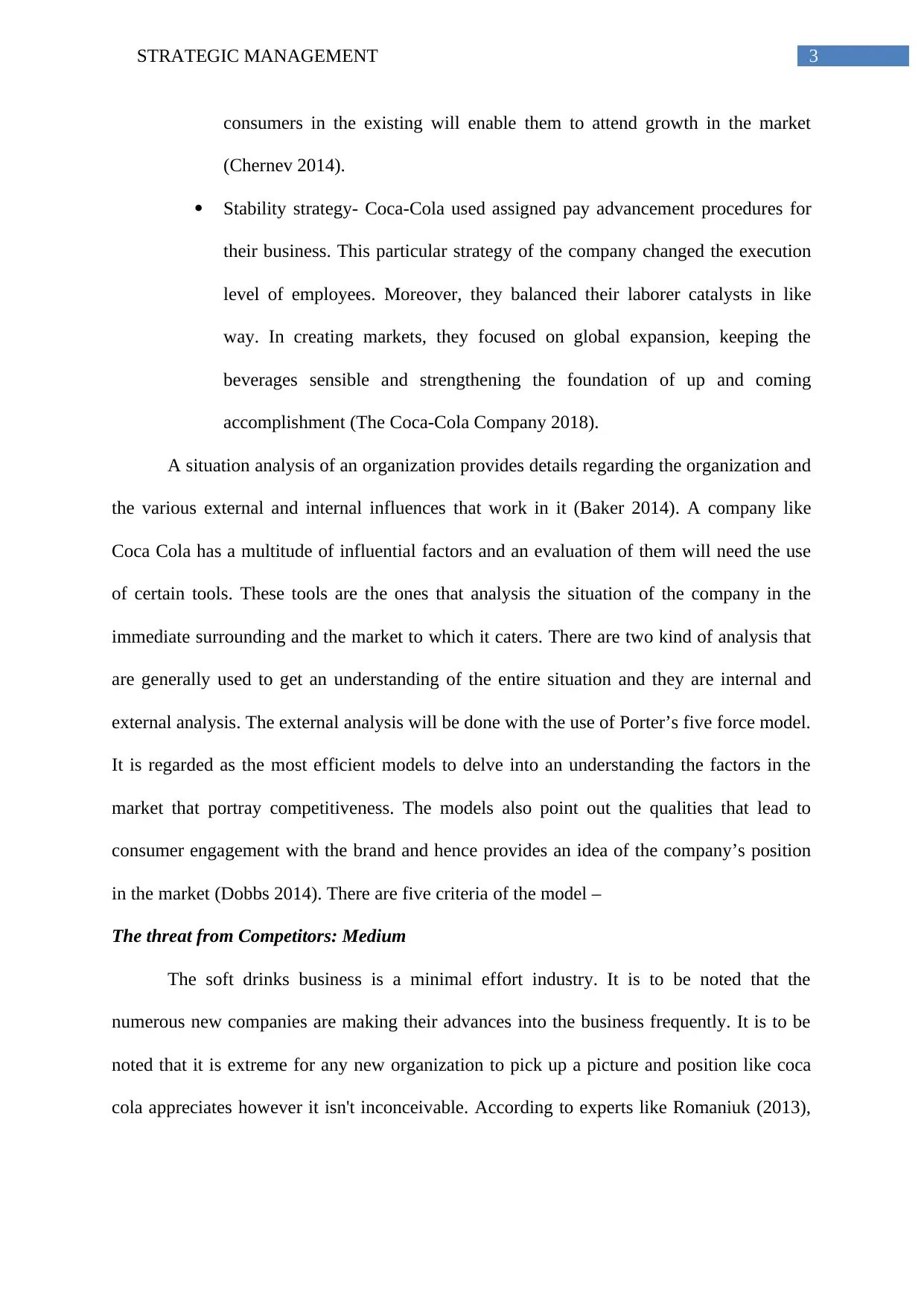
3STRATEGIC MANAGEMENT
consumers in the existing will enable them to attend growth in the market
(Chernev 2014).
Stability strategy- Coca-Cola used assigned pay advancement procedures for
their business. This particular strategy of the company changed the execution
level of employees. Moreover, they balanced their laborer catalysts in like
way. In creating markets, they focused on global expansion, keeping the
beverages sensible and strengthening the foundation of up and coming
accomplishment (The Coca-Cola Company 2018).
A situation analysis of an organization provides details regarding the organization and
the various external and internal influences that work in it (Baker 2014). A company like
Coca Cola has a multitude of influential factors and an evaluation of them will need the use
of certain tools. These tools are the ones that analysis the situation of the company in the
immediate surrounding and the market to which it caters. There are two kind of analysis that
are generally used to get an understanding of the entire situation and they are internal and
external analysis. The external analysis will be done with the use of Porter’s five force model.
It is regarded as the most efficient models to delve into an understanding the factors in the
market that portray competitiveness. The models also point out the qualities that lead to
consumer engagement with the brand and hence provides an idea of the company’s position
in the market (Dobbs 2014). There are five criteria of the model –
The threat from Competitors: Medium
The soft drinks business is a minimal effort industry. It is to be noted that the
numerous new companies are making their advances into the business frequently. It is to be
noted that it is extreme for any new organization to pick up a picture and position like coca
cola appreciates however it isn't inconceivable. According to experts like Romaniuk (2013),
consumers in the existing will enable them to attend growth in the market
(Chernev 2014).
Stability strategy- Coca-Cola used assigned pay advancement procedures for
their business. This particular strategy of the company changed the execution
level of employees. Moreover, they balanced their laborer catalysts in like
way. In creating markets, they focused on global expansion, keeping the
beverages sensible and strengthening the foundation of up and coming
accomplishment (The Coca-Cola Company 2018).
A situation analysis of an organization provides details regarding the organization and
the various external and internal influences that work in it (Baker 2014). A company like
Coca Cola has a multitude of influential factors and an evaluation of them will need the use
of certain tools. These tools are the ones that analysis the situation of the company in the
immediate surrounding and the market to which it caters. There are two kind of analysis that
are generally used to get an understanding of the entire situation and they are internal and
external analysis. The external analysis will be done with the use of Porter’s five force model.
It is regarded as the most efficient models to delve into an understanding the factors in the
market that portray competitiveness. The models also point out the qualities that lead to
consumer engagement with the brand and hence provides an idea of the company’s position
in the market (Dobbs 2014). There are five criteria of the model –
The threat from Competitors: Medium
The soft drinks business is a minimal effort industry. It is to be noted that the
numerous new companies are making their advances into the business frequently. It is to be
noted that it is extreme for any new organization to pick up a picture and position like coca
cola appreciates however it isn't inconceivable. According to experts like Romaniuk (2013),
Paraphrase This Document
Need a fresh take? Get an instant paraphrase of this document with our AI Paraphraser
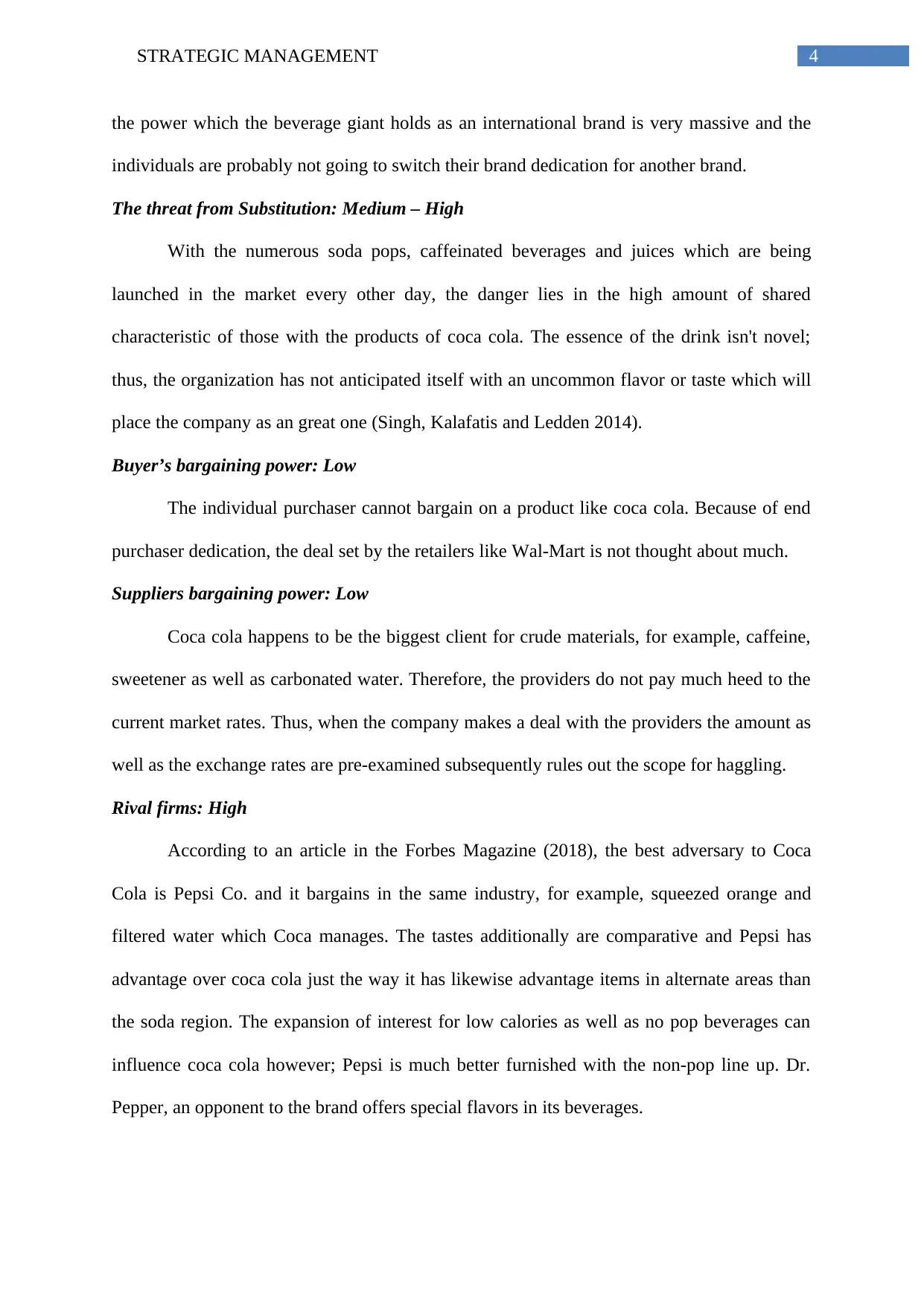
4STRATEGIC MANAGEMENT
the power which the beverage giant holds as an international brand is very massive and the
individuals are probably not going to switch their brand dedication for another brand.
The threat from Substitution: Medium – High
With the numerous soda pops, caffeinated beverages and juices which are being
launched in the market every other day, the danger lies in the high amount of shared
characteristic of those with the products of coca cola. The essence of the drink isn't novel;
thus, the organization has not anticipated itself with an uncommon flavor or taste which will
place the company as an great one (Singh, Kalafatis and Ledden 2014).
Buyer’s bargaining power: Low
The individual purchaser cannot bargain on a product like coca cola. Because of end
purchaser dedication, the deal set by the retailers like Wal-Mart is not thought about much.
Suppliers bargaining power: Low
Coca cola happens to be the biggest client for crude materials, for example, caffeine,
sweetener as well as carbonated water. Therefore, the providers do not pay much heed to the
current market rates. Thus, when the company makes a deal with the providers the amount as
well as the exchange rates are pre-examined subsequently rules out the scope for haggling.
Rival firms: High
According to an article in the Forbes Magazine (2018), the best adversary to Coca
Cola is Pepsi Co. and it bargains in the same industry, for example, squeezed orange and
filtered water which Coca manages. The tastes additionally are comparative and Pepsi has
advantage over coca cola just the way it has likewise advantage items in alternate areas than
the soda region. The expansion of interest for low calories as well as no pop beverages can
influence coca cola however; Pepsi is much better furnished with the non-pop line up. Dr.
Pepper, an opponent to the brand offers special flavors in its beverages.
the power which the beverage giant holds as an international brand is very massive and the
individuals are probably not going to switch their brand dedication for another brand.
The threat from Substitution: Medium – High
With the numerous soda pops, caffeinated beverages and juices which are being
launched in the market every other day, the danger lies in the high amount of shared
characteristic of those with the products of coca cola. The essence of the drink isn't novel;
thus, the organization has not anticipated itself with an uncommon flavor or taste which will
place the company as an great one (Singh, Kalafatis and Ledden 2014).
Buyer’s bargaining power: Low
The individual purchaser cannot bargain on a product like coca cola. Because of end
purchaser dedication, the deal set by the retailers like Wal-Mart is not thought about much.
Suppliers bargaining power: Low
Coca cola happens to be the biggest client for crude materials, for example, caffeine,
sweetener as well as carbonated water. Therefore, the providers do not pay much heed to the
current market rates. Thus, when the company makes a deal with the providers the amount as
well as the exchange rates are pre-examined subsequently rules out the scope for haggling.
Rival firms: High
According to an article in the Forbes Magazine (2018), the best adversary to Coca
Cola is Pepsi Co. and it bargains in the same industry, for example, squeezed orange and
filtered water which Coca manages. The tastes additionally are comparative and Pepsi has
advantage over coca cola just the way it has likewise advantage items in alternate areas than
the soda region. The expansion of interest for low calories as well as no pop beverages can
influence coca cola however; Pepsi is much better furnished with the non-pop line up. Dr.
Pepper, an opponent to the brand offers special flavors in its beverages.
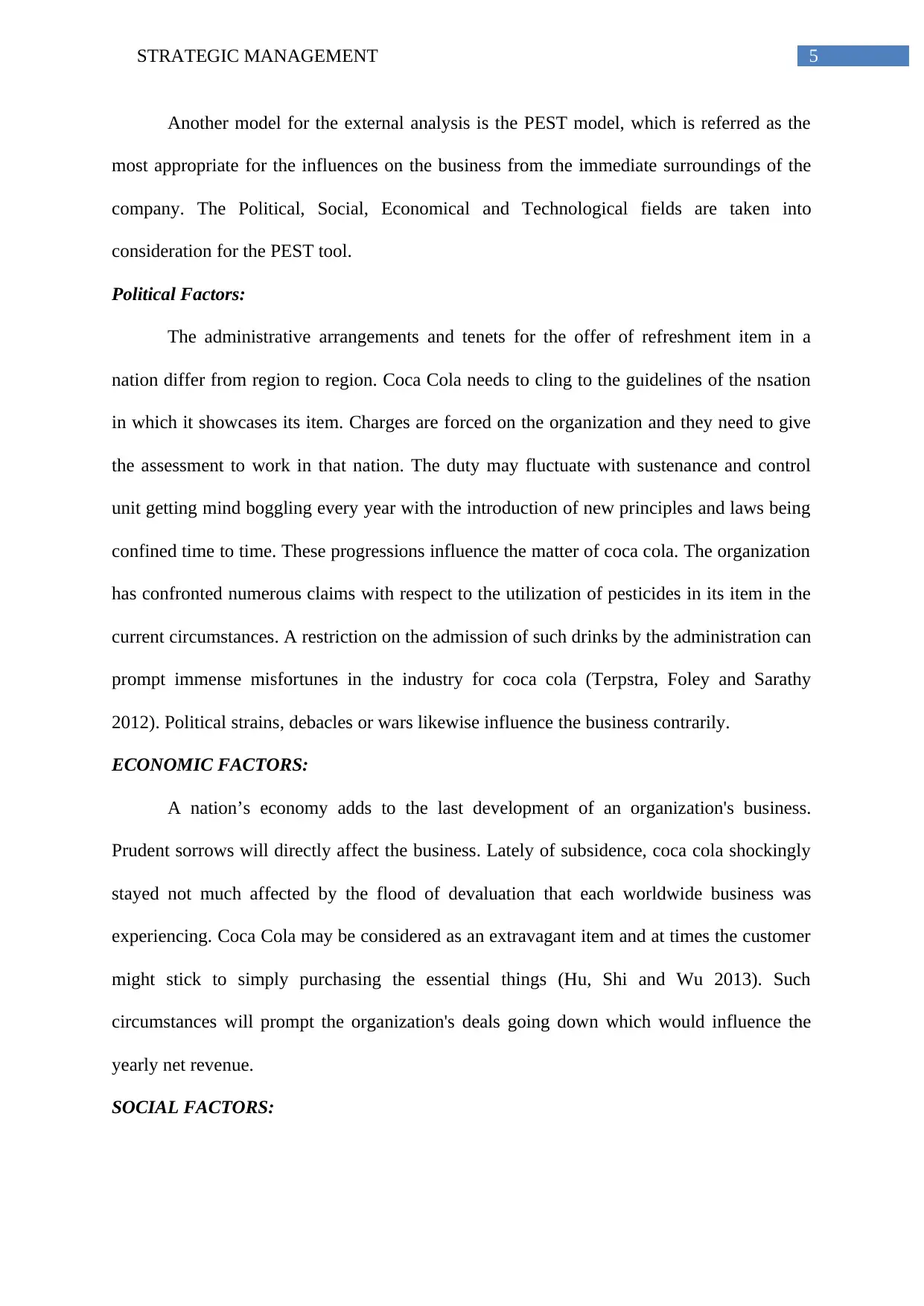
5STRATEGIC MANAGEMENT
Another model for the external analysis is the PEST model, which is referred as the
most appropriate for the influences on the business from the immediate surroundings of the
company. The Political, Social, Economical and Technological fields are taken into
consideration for the PEST tool.
Political Factors:
The administrative arrangements and tenets for the offer of refreshment item in a
nation differ from region to region. Coca Cola needs to cling to the guidelines of the nsation
in which it showcases its item. Charges are forced on the organization and they need to give
the assessment to work in that nation. The duty may fluctuate with sustenance and control
unit getting mind boggling every year with the introduction of new principles and laws being
confined time to time. These progressions influence the matter of coca cola. The organization
has confronted numerous claims with respect to the utilization of pesticides in its item in the
current circumstances. A restriction on the admission of such drinks by the administration can
prompt immense misfortunes in the industry for coca cola (Terpstra, Foley and Sarathy
2012). Political strains, debacles or wars likewise influence the business contrarily.
ECONOMIC FACTORS:
A nation’s economy adds to the last development of an organization's business.
Prudent sorrows will directly affect the business. Lately of subsidence, coca cola shockingly
stayed not much affected by the flood of devaluation that each worldwide business was
experiencing. Coca Cola may be considered as an extravagant item and at times the customer
might stick to simply purchasing the essential things (Hu, Shi and Wu 2013). Such
circumstances will prompt the organization's deals going down which would influence the
yearly net revenue.
SOCIAL FACTORS:
Another model for the external analysis is the PEST model, which is referred as the
most appropriate for the influences on the business from the immediate surroundings of the
company. The Political, Social, Economical and Technological fields are taken into
consideration for the PEST tool.
Political Factors:
The administrative arrangements and tenets for the offer of refreshment item in a
nation differ from region to region. Coca Cola needs to cling to the guidelines of the nsation
in which it showcases its item. Charges are forced on the organization and they need to give
the assessment to work in that nation. The duty may fluctuate with sustenance and control
unit getting mind boggling every year with the introduction of new principles and laws being
confined time to time. These progressions influence the matter of coca cola. The organization
has confronted numerous claims with respect to the utilization of pesticides in its item in the
current circumstances. A restriction on the admission of such drinks by the administration can
prompt immense misfortunes in the industry for coca cola (Terpstra, Foley and Sarathy
2012). Political strains, debacles or wars likewise influence the business contrarily.
ECONOMIC FACTORS:
A nation’s economy adds to the last development of an organization's business.
Prudent sorrows will directly affect the business. Lately of subsidence, coca cola shockingly
stayed not much affected by the flood of devaluation that each worldwide business was
experiencing. Coca Cola may be considered as an extravagant item and at times the customer
might stick to simply purchasing the essential things (Hu, Shi and Wu 2013). Such
circumstances will prompt the organization's deals going down which would influence the
yearly net revenue.
SOCIAL FACTORS:
⊘ This is a preview!⊘
Do you want full access?
Subscribe today to unlock all pages.

Trusted by 1+ million students worldwide
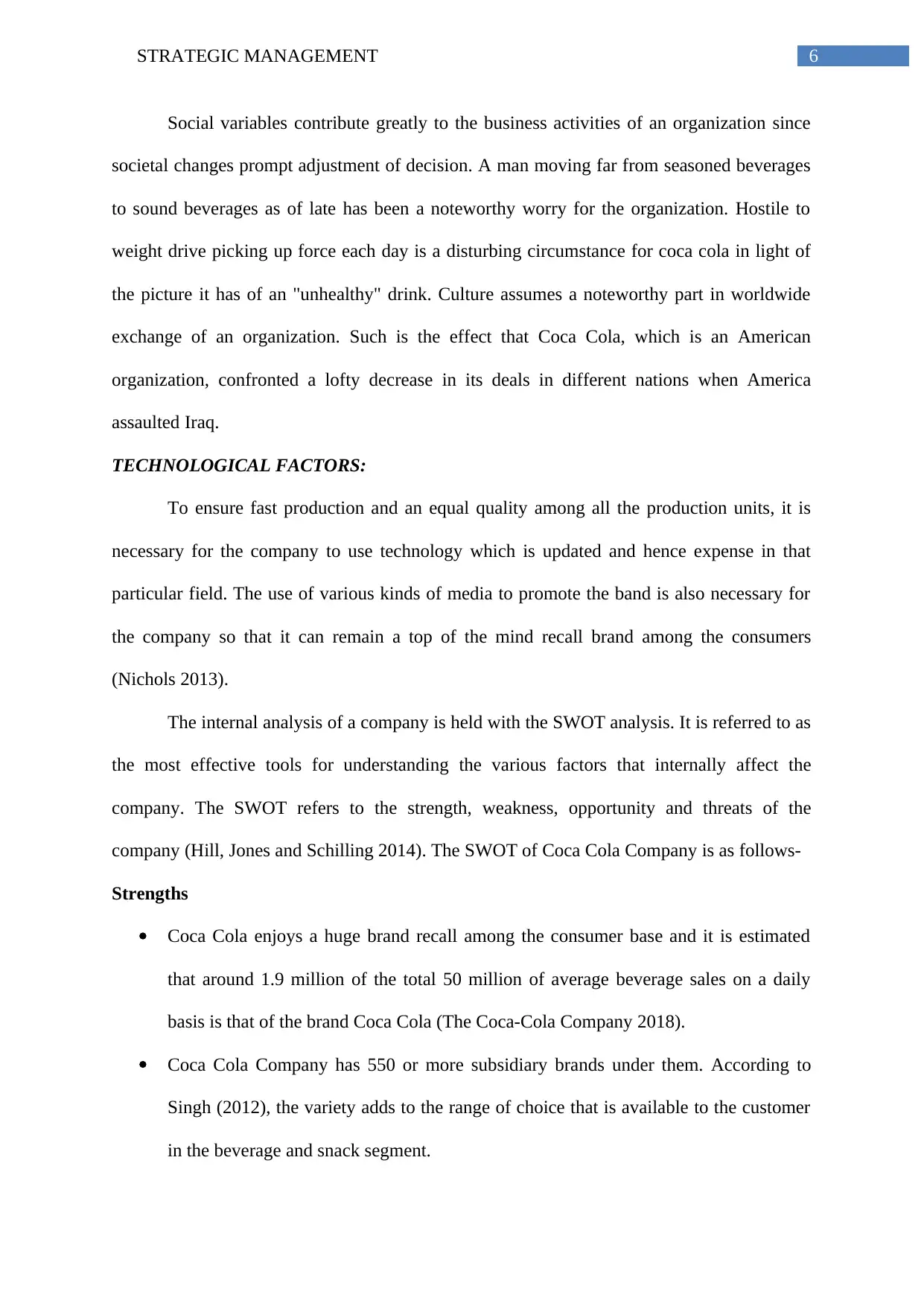
6STRATEGIC MANAGEMENT
Social variables contribute greatly to the business activities of an organization since
societal changes prompt adjustment of decision. A man moving far from seasoned beverages
to sound beverages as of late has been a noteworthy worry for the organization. Hostile to
weight drive picking up force each day is a disturbing circumstance for coca cola in light of
the picture it has of an "unhealthy" drink. Culture assumes a noteworthy part in worldwide
exchange of an organization. Such is the effect that Coca Cola, which is an American
organization, confronted a lofty decrease in its deals in different nations when America
assaulted Iraq.
TECHNOLOGICAL FACTORS:
To ensure fast production and an equal quality among all the production units, it is
necessary for the company to use technology which is updated and hence expense in that
particular field. The use of various kinds of media to promote the band is also necessary for
the company so that it can remain a top of the mind recall brand among the consumers
(Nichols 2013).
The internal analysis of a company is held with the SWOT analysis. It is referred to as
the most effective tools for understanding the various factors that internally affect the
company. The SWOT refers to the strength, weakness, opportunity and threats of the
company (Hill, Jones and Schilling 2014). The SWOT of Coca Cola Company is as follows-
Strengths
Coca Cola enjoys a huge brand recall among the consumer base and it is estimated
that around 1.9 million of the total 50 million of average beverage sales on a daily
basis is that of the brand Coca Cola (The Coca-Cola Company 2018).
Coca Cola Company has 550 or more subsidiary brands under them. According to
Singh (2012), the variety adds to the range of choice that is available to the customer
in the beverage and snack segment.
Social variables contribute greatly to the business activities of an organization since
societal changes prompt adjustment of decision. A man moving far from seasoned beverages
to sound beverages as of late has been a noteworthy worry for the organization. Hostile to
weight drive picking up force each day is a disturbing circumstance for coca cola in light of
the picture it has of an "unhealthy" drink. Culture assumes a noteworthy part in worldwide
exchange of an organization. Such is the effect that Coca Cola, which is an American
organization, confronted a lofty decrease in its deals in different nations when America
assaulted Iraq.
TECHNOLOGICAL FACTORS:
To ensure fast production and an equal quality among all the production units, it is
necessary for the company to use technology which is updated and hence expense in that
particular field. The use of various kinds of media to promote the band is also necessary for
the company so that it can remain a top of the mind recall brand among the consumers
(Nichols 2013).
The internal analysis of a company is held with the SWOT analysis. It is referred to as
the most effective tools for understanding the various factors that internally affect the
company. The SWOT refers to the strength, weakness, opportunity and threats of the
company (Hill, Jones and Schilling 2014). The SWOT of Coca Cola Company is as follows-
Strengths
Coca Cola enjoys a huge brand recall among the consumer base and it is estimated
that around 1.9 million of the total 50 million of average beverage sales on a daily
basis is that of the brand Coca Cola (The Coca-Cola Company 2018).
Coca Cola Company has 550 or more subsidiary brands under them. According to
Singh (2012), the variety adds to the range of choice that is available to the customer
in the beverage and snack segment.
Paraphrase This Document
Need a fresh take? Get an instant paraphrase of this document with our AI Paraphraser
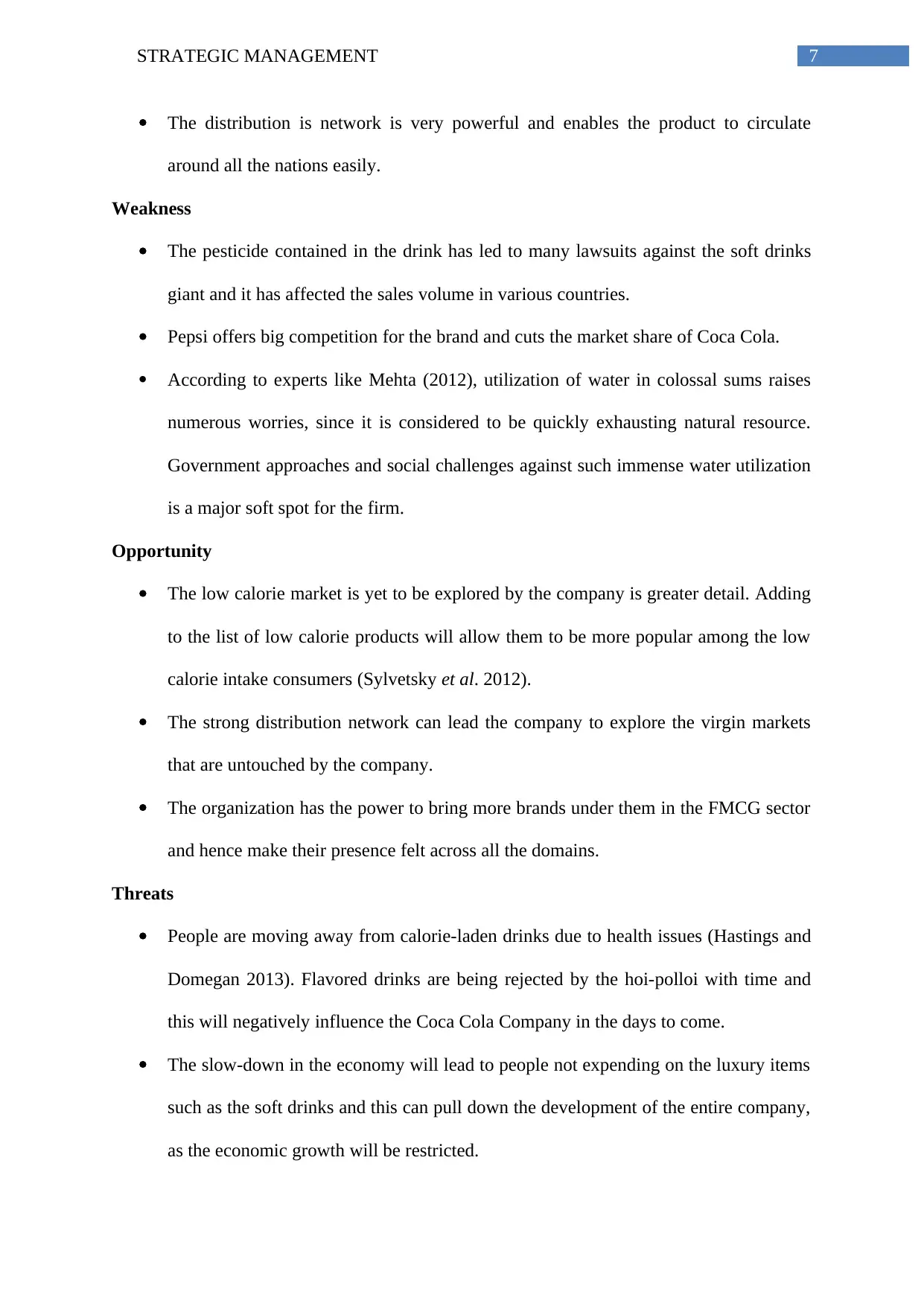
7STRATEGIC MANAGEMENT
The distribution is network is very powerful and enables the product to circulate
around all the nations easily.
Weakness
The pesticide contained in the drink has led to many lawsuits against the soft drinks
giant and it has affected the sales volume in various countries.
Pepsi offers big competition for the brand and cuts the market share of Coca Cola.
According to experts like Mehta (2012), utilization of water in colossal sums raises
numerous worries, since it is considered to be quickly exhausting natural resource.
Government approaches and social challenges against such immense water utilization
is a major soft spot for the firm.
Opportunity
The low calorie market is yet to be explored by the company is greater detail. Adding
to the list of low calorie products will allow them to be more popular among the low
calorie intake consumers (Sylvetsky et al. 2012).
The strong distribution network can lead the company to explore the virgin markets
that are untouched by the company.
The organization has the power to bring more brands under them in the FMCG sector
and hence make their presence felt across all the domains.
Threats
People are moving away from calorie-laden drinks due to health issues (Hastings and
Domegan 2013). Flavored drinks are being rejected by the hoi-polloi with time and
this will negatively influence the Coca Cola Company in the days to come.
The slow-down in the economy will lead to people not expending on the luxury items
such as the soft drinks and this can pull down the development of the entire company,
as the economic growth will be restricted.
The distribution is network is very powerful and enables the product to circulate
around all the nations easily.
Weakness
The pesticide contained in the drink has led to many lawsuits against the soft drinks
giant and it has affected the sales volume in various countries.
Pepsi offers big competition for the brand and cuts the market share of Coca Cola.
According to experts like Mehta (2012), utilization of water in colossal sums raises
numerous worries, since it is considered to be quickly exhausting natural resource.
Government approaches and social challenges against such immense water utilization
is a major soft spot for the firm.
Opportunity
The low calorie market is yet to be explored by the company is greater detail. Adding
to the list of low calorie products will allow them to be more popular among the low
calorie intake consumers (Sylvetsky et al. 2012).
The strong distribution network can lead the company to explore the virgin markets
that are untouched by the company.
The organization has the power to bring more brands under them in the FMCG sector
and hence make their presence felt across all the domains.
Threats
People are moving away from calorie-laden drinks due to health issues (Hastings and
Domegan 2013). Flavored drinks are being rejected by the hoi-polloi with time and
this will negatively influence the Coca Cola Company in the days to come.
The slow-down in the economy will lead to people not expending on the luxury items
such as the soft drinks and this can pull down the development of the entire company,
as the economic growth will be restricted.
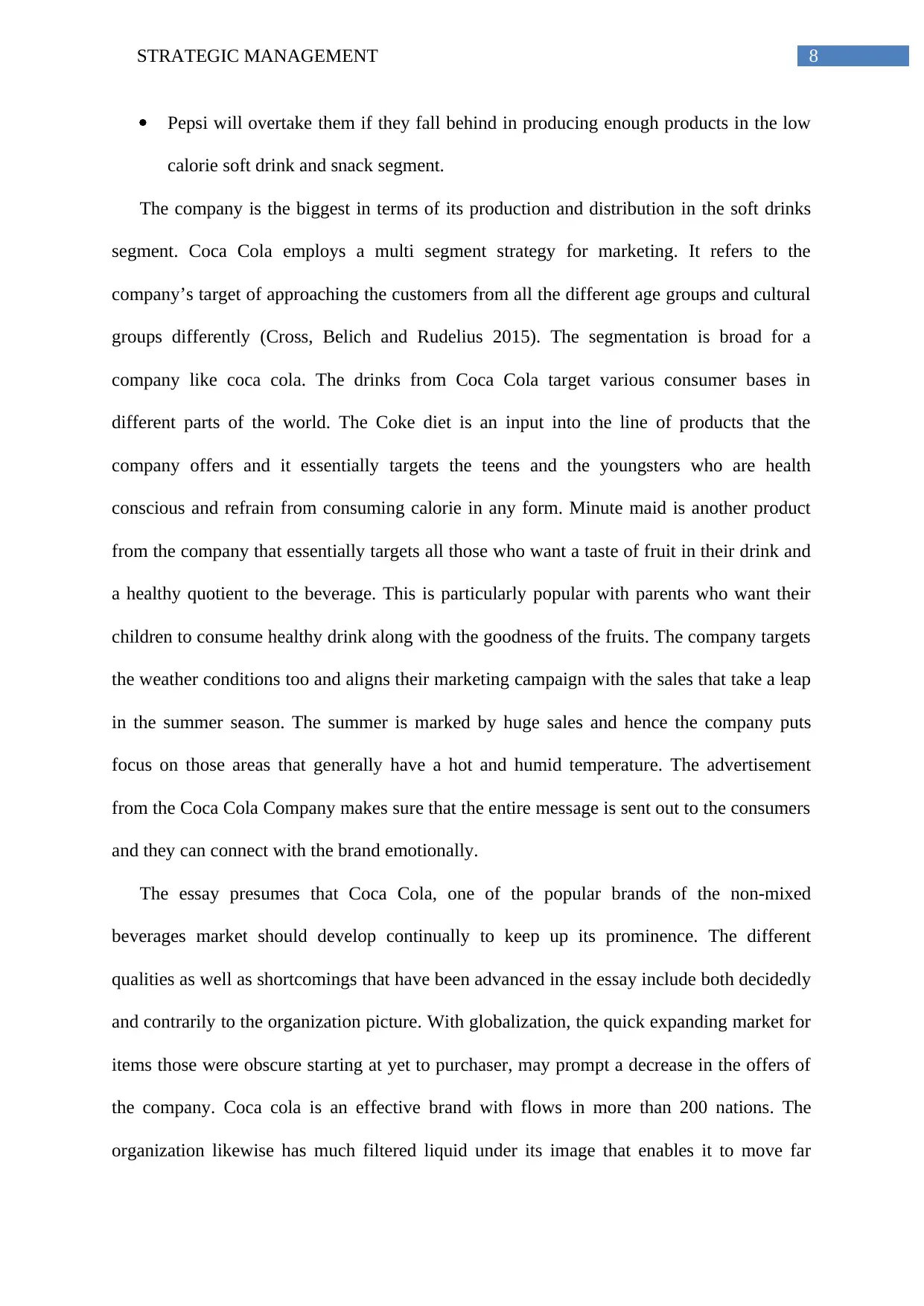
8STRATEGIC MANAGEMENT
Pepsi will overtake them if they fall behind in producing enough products in the low
calorie soft drink and snack segment.
The company is the biggest in terms of its production and distribution in the soft drinks
segment. Coca Cola employs a multi segment strategy for marketing. It refers to the
company’s target of approaching the customers from all the different age groups and cultural
groups differently (Cross, Belich and Rudelius 2015). The segmentation is broad for a
company like coca cola. The drinks from Coca Cola target various consumer bases in
different parts of the world. The Coke diet is an input into the line of products that the
company offers and it essentially targets the teens and the youngsters who are health
conscious and refrain from consuming calorie in any form. Minute maid is another product
from the company that essentially targets all those who want a taste of fruit in their drink and
a healthy quotient to the beverage. This is particularly popular with parents who want their
children to consume healthy drink along with the goodness of the fruits. The company targets
the weather conditions too and aligns their marketing campaign with the sales that take a leap
in the summer season. The summer is marked by huge sales and hence the company puts
focus on those areas that generally have a hot and humid temperature. The advertisement
from the Coca Cola Company makes sure that the entire message is sent out to the consumers
and they can connect with the brand emotionally.
The essay presumes that Coca Cola, one of the popular brands of the non-mixed
beverages market should develop continually to keep up its prominence. The different
qualities as well as shortcomings that have been advanced in the essay include both decidedly
and contrarily to the organization picture. With globalization, the quick expanding market for
items those were obscure starting at yet to purchaser, may prompt a decrease in the offers of
the company. Coca cola is an effective brand with flows in more than 200 nations. The
organization likewise has much filtered liquid under its image that enables it to move far
Pepsi will overtake them if they fall behind in producing enough products in the low
calorie soft drink and snack segment.
The company is the biggest in terms of its production and distribution in the soft drinks
segment. Coca Cola employs a multi segment strategy for marketing. It refers to the
company’s target of approaching the customers from all the different age groups and cultural
groups differently (Cross, Belich and Rudelius 2015). The segmentation is broad for a
company like coca cola. The drinks from Coca Cola target various consumer bases in
different parts of the world. The Coke diet is an input into the line of products that the
company offers and it essentially targets the teens and the youngsters who are health
conscious and refrain from consuming calorie in any form. Minute maid is another product
from the company that essentially targets all those who want a taste of fruit in their drink and
a healthy quotient to the beverage. This is particularly popular with parents who want their
children to consume healthy drink along with the goodness of the fruits. The company targets
the weather conditions too and aligns their marketing campaign with the sales that take a leap
in the summer season. The summer is marked by huge sales and hence the company puts
focus on those areas that generally have a hot and humid temperature. The advertisement
from the Coca Cola Company makes sure that the entire message is sent out to the consumers
and they can connect with the brand emotionally.
The essay presumes that Coca Cola, one of the popular brands of the non-mixed
beverages market should develop continually to keep up its prominence. The different
qualities as well as shortcomings that have been advanced in the essay include both decidedly
and contrarily to the organization picture. With globalization, the quick expanding market for
items those were obscure starting at yet to purchaser, may prompt a decrease in the offers of
the company. Coca cola is an effective brand with flows in more than 200 nations. The
organization likewise has much filtered liquid under its image that enables it to move far
⊘ This is a preview!⊘
Do you want full access?
Subscribe today to unlock all pages.

Trusted by 1+ million students worldwide
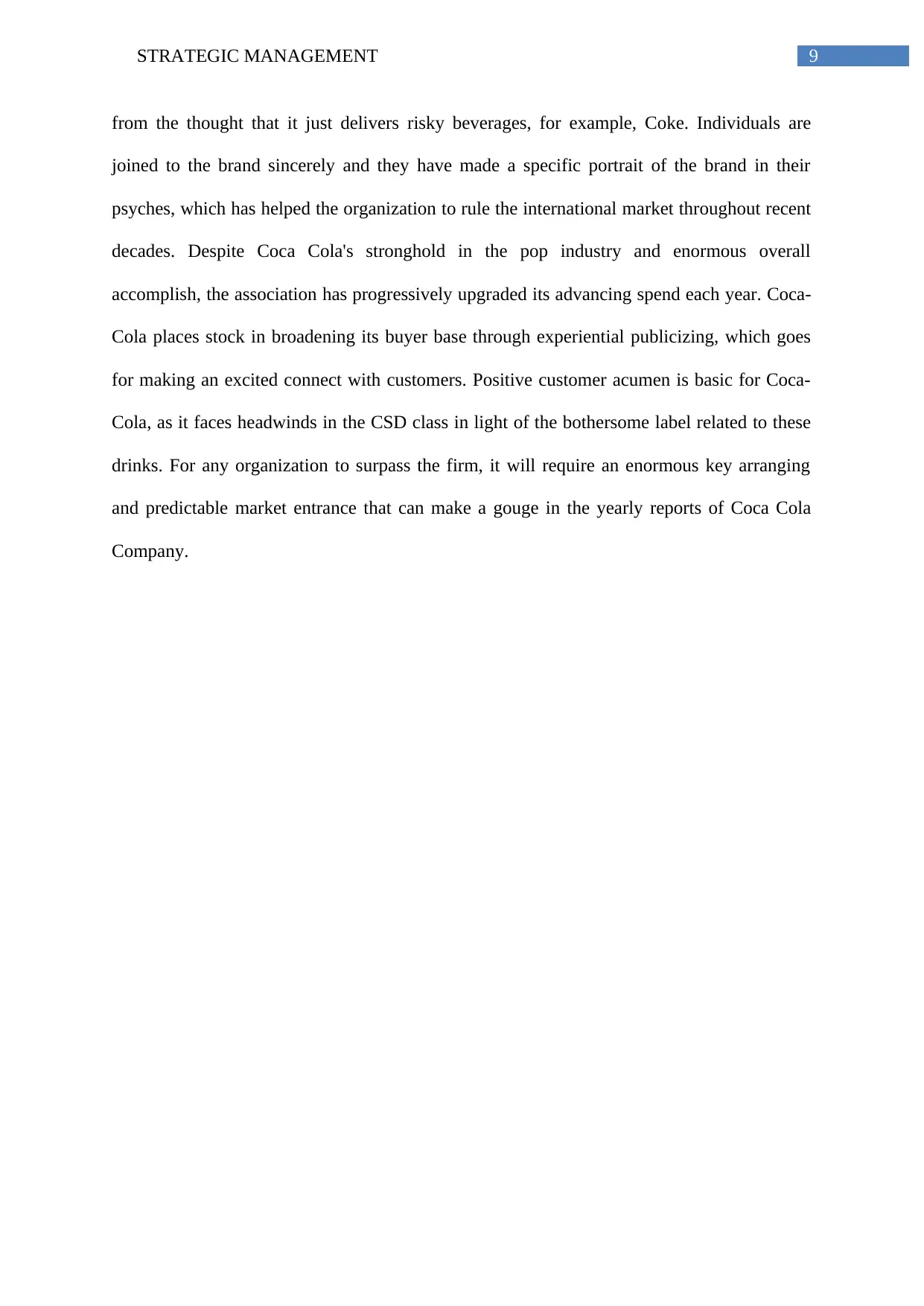
9STRATEGIC MANAGEMENT
from the thought that it just delivers risky beverages, for example, Coke. Individuals are
joined to the brand sincerely and they have made a specific portrait of the brand in their
psyches, which has helped the organization to rule the international market throughout recent
decades. Despite Coca Cola's stronghold in the pop industry and enormous overall
accomplish, the association has progressively upgraded its advancing spend each year. Coca-
Cola places stock in broadening its buyer base through experiential publicizing, which goes
for making an excited connect with customers. Positive customer acumen is basic for Coca-
Cola, as it faces headwinds in the CSD class in light of the bothersome label related to these
drinks. For any organization to surpass the firm, it will require an enormous key arranging
and predictable market entrance that can make a gouge in the yearly reports of Coca Cola
Company.
from the thought that it just delivers risky beverages, for example, Coke. Individuals are
joined to the brand sincerely and they have made a specific portrait of the brand in their
psyches, which has helped the organization to rule the international market throughout recent
decades. Despite Coca Cola's stronghold in the pop industry and enormous overall
accomplish, the association has progressively upgraded its advancing spend each year. Coca-
Cola places stock in broadening its buyer base through experiential publicizing, which goes
for making an excited connect with customers. Positive customer acumen is basic for Coca-
Cola, as it faces headwinds in the CSD class in light of the bothersome label related to these
drinks. For any organization to surpass the firm, it will require an enormous key arranging
and predictable market entrance that can make a gouge in the yearly reports of Coca Cola
Company.
Paraphrase This Document
Need a fresh take? Get an instant paraphrase of this document with our AI Paraphraser
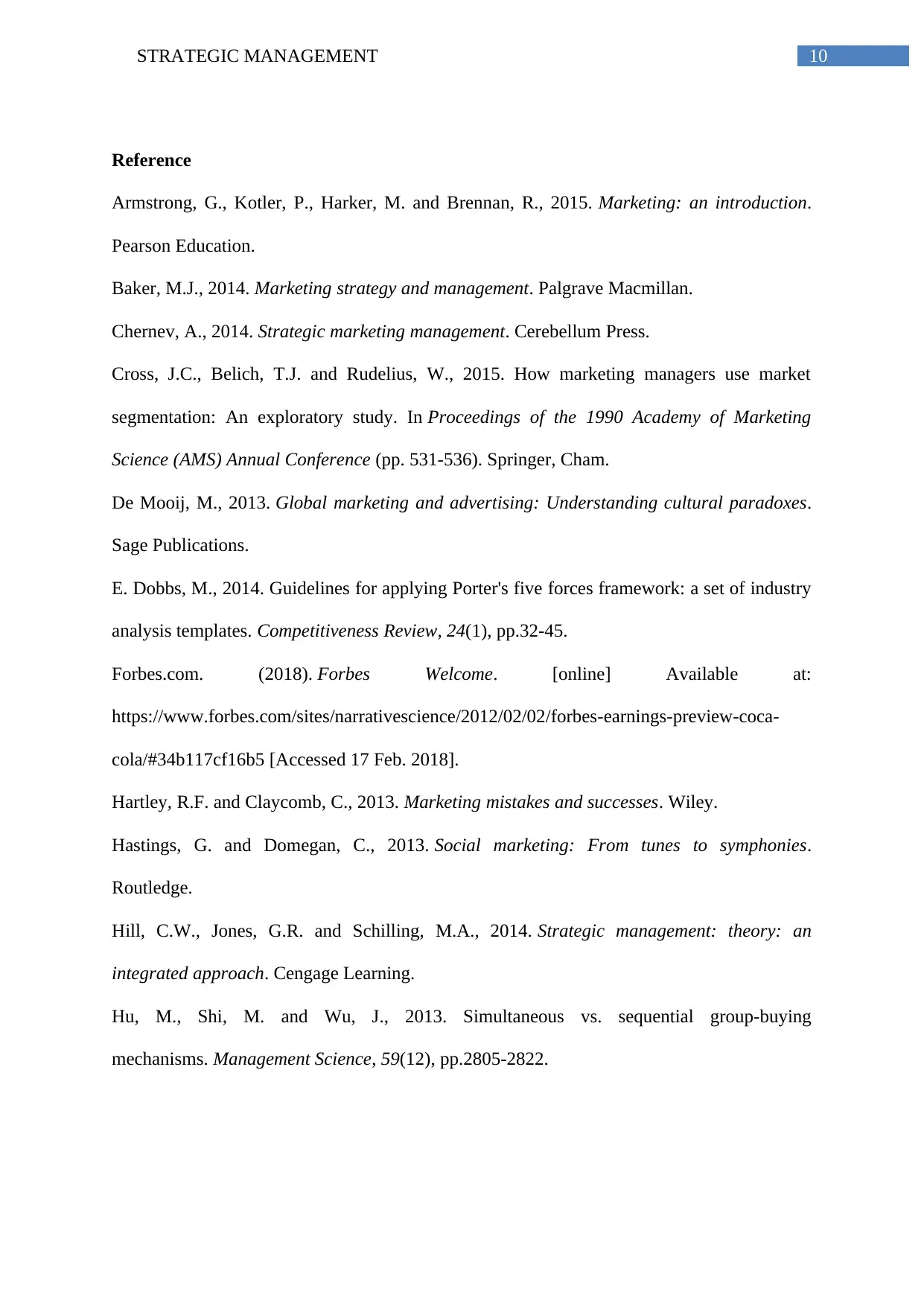
10STRATEGIC MANAGEMENT
Reference
Armstrong, G., Kotler, P., Harker, M. and Brennan, R., 2015. Marketing: an introduction.
Pearson Education.
Baker, M.J., 2014. Marketing strategy and management. Palgrave Macmillan.
Chernev, A., 2014. Strategic marketing management. Cerebellum Press.
Cross, J.C., Belich, T.J. and Rudelius, W., 2015. How marketing managers use market
segmentation: An exploratory study. In Proceedings of the 1990 Academy of Marketing
Science (AMS) Annual Conference (pp. 531-536). Springer, Cham.
De Mooij, M., 2013. Global marketing and advertising: Understanding cultural paradoxes.
Sage Publications.
E. Dobbs, M., 2014. Guidelines for applying Porter's five forces framework: a set of industry
analysis templates. Competitiveness Review, 24(1), pp.32-45.
Forbes.com. (2018). Forbes Welcome. [online] Available at:
https://www.forbes.com/sites/narrativescience/2012/02/02/forbes-earnings-preview-coca-
cola/#34b117cf16b5 [Accessed 17 Feb. 2018].
Hartley, R.F. and Claycomb, C., 2013. Marketing mistakes and successes. Wiley.
Hastings, G. and Domegan, C., 2013. Social marketing: From tunes to symphonies.
Routledge.
Hill, C.W., Jones, G.R. and Schilling, M.A., 2014. Strategic management: theory: an
integrated approach. Cengage Learning.
Hu, M., Shi, M. and Wu, J., 2013. Simultaneous vs. sequential group-buying
mechanisms. Management Science, 59(12), pp.2805-2822.
Reference
Armstrong, G., Kotler, P., Harker, M. and Brennan, R., 2015. Marketing: an introduction.
Pearson Education.
Baker, M.J., 2014. Marketing strategy and management. Palgrave Macmillan.
Chernev, A., 2014. Strategic marketing management. Cerebellum Press.
Cross, J.C., Belich, T.J. and Rudelius, W., 2015. How marketing managers use market
segmentation: An exploratory study. In Proceedings of the 1990 Academy of Marketing
Science (AMS) Annual Conference (pp. 531-536). Springer, Cham.
De Mooij, M., 2013. Global marketing and advertising: Understanding cultural paradoxes.
Sage Publications.
E. Dobbs, M., 2014. Guidelines for applying Porter's five forces framework: a set of industry
analysis templates. Competitiveness Review, 24(1), pp.32-45.
Forbes.com. (2018). Forbes Welcome. [online] Available at:
https://www.forbes.com/sites/narrativescience/2012/02/02/forbes-earnings-preview-coca-
cola/#34b117cf16b5 [Accessed 17 Feb. 2018].
Hartley, R.F. and Claycomb, C., 2013. Marketing mistakes and successes. Wiley.
Hastings, G. and Domegan, C., 2013. Social marketing: From tunes to symphonies.
Routledge.
Hill, C.W., Jones, G.R. and Schilling, M.A., 2014. Strategic management: theory: an
integrated approach. Cengage Learning.
Hu, M., Shi, M. and Wu, J., 2013. Simultaneous vs. sequential group-buying
mechanisms. Management Science, 59(12), pp.2805-2822.
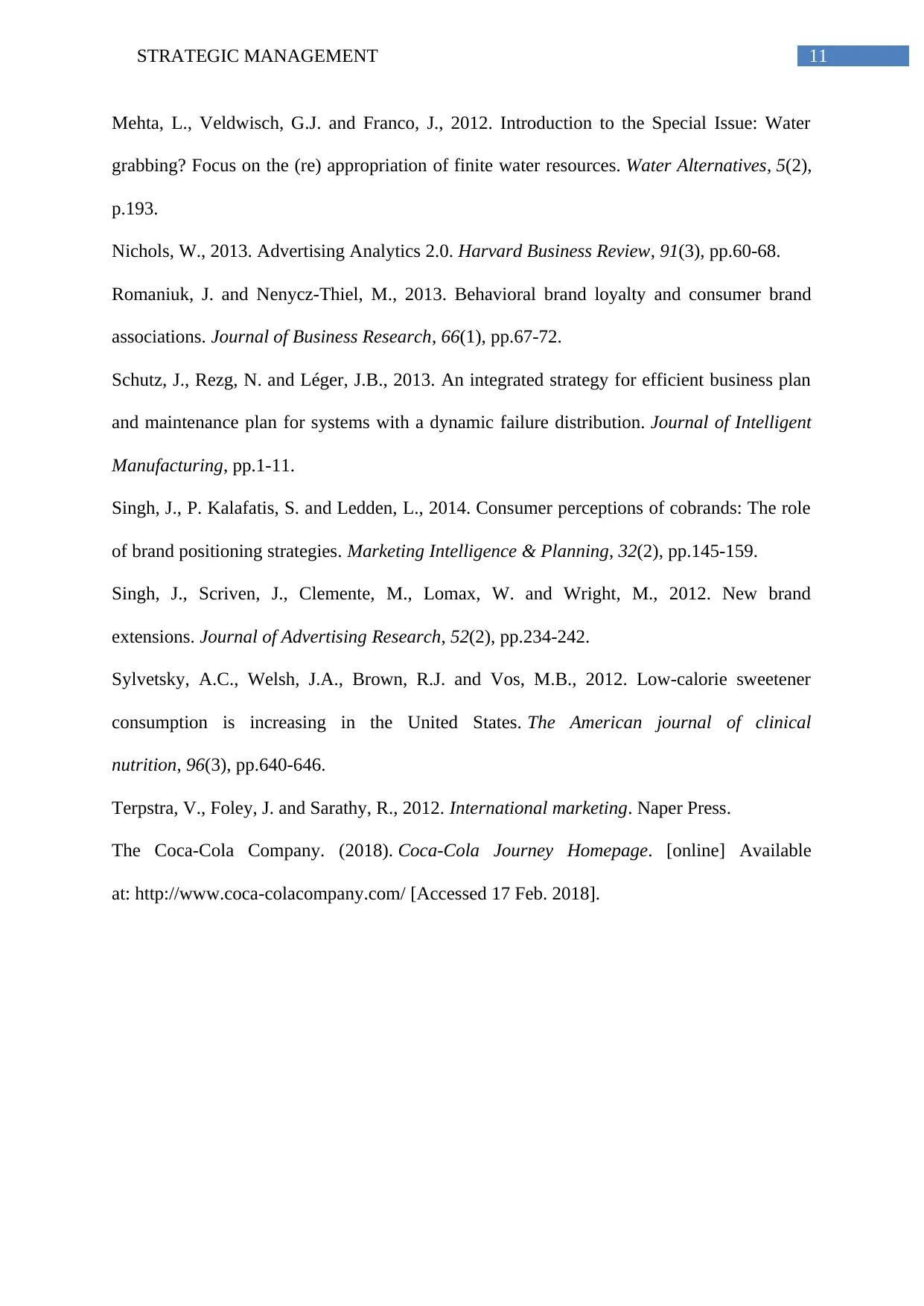
11STRATEGIC MANAGEMENT
Mehta, L., Veldwisch, G.J. and Franco, J., 2012. Introduction to the Special Issue: Water
grabbing? Focus on the (re) appropriation of finite water resources. Water Alternatives, 5(2),
p.193.
Nichols, W., 2013. Advertising Analytics 2.0. Harvard Business Review, 91(3), pp.60-68.
Romaniuk, J. and Nenycz-Thiel, M., 2013. Behavioral brand loyalty and consumer brand
associations. Journal of Business Research, 66(1), pp.67-72.
Schutz, J., Rezg, N. and Léger, J.B., 2013. An integrated strategy for efficient business plan
and maintenance plan for systems with a dynamic failure distribution. Journal of Intelligent
Manufacturing, pp.1-11.
Singh, J., P. Kalafatis, S. and Ledden, L., 2014. Consumer perceptions of cobrands: The role
of brand positioning strategies. Marketing Intelligence & Planning, 32(2), pp.145-159.
Singh, J., Scriven, J., Clemente, M., Lomax, W. and Wright, M., 2012. New brand
extensions. Journal of Advertising Research, 52(2), pp.234-242.
Sylvetsky, A.C., Welsh, J.A., Brown, R.J. and Vos, M.B., 2012. Low-calorie sweetener
consumption is increasing in the United States. The American journal of clinical
nutrition, 96(3), pp.640-646.
Terpstra, V., Foley, J. and Sarathy, R., 2012. International marketing. Naper Press.
The Coca-Cola Company. (2018). Coca-Cola Journey Homepage. [online] Available
at: http://www.coca-colacompany.com/ [Accessed 17 Feb. 2018].
Mehta, L., Veldwisch, G.J. and Franco, J., 2012. Introduction to the Special Issue: Water
grabbing? Focus on the (re) appropriation of finite water resources. Water Alternatives, 5(2),
p.193.
Nichols, W., 2013. Advertising Analytics 2.0. Harvard Business Review, 91(3), pp.60-68.
Romaniuk, J. and Nenycz-Thiel, M., 2013. Behavioral brand loyalty and consumer brand
associations. Journal of Business Research, 66(1), pp.67-72.
Schutz, J., Rezg, N. and Léger, J.B., 2013. An integrated strategy for efficient business plan
and maintenance plan for systems with a dynamic failure distribution. Journal of Intelligent
Manufacturing, pp.1-11.
Singh, J., P. Kalafatis, S. and Ledden, L., 2014. Consumer perceptions of cobrands: The role
of brand positioning strategies. Marketing Intelligence & Planning, 32(2), pp.145-159.
Singh, J., Scriven, J., Clemente, M., Lomax, W. and Wright, M., 2012. New brand
extensions. Journal of Advertising Research, 52(2), pp.234-242.
Sylvetsky, A.C., Welsh, J.A., Brown, R.J. and Vos, M.B., 2012. Low-calorie sweetener
consumption is increasing in the United States. The American journal of clinical
nutrition, 96(3), pp.640-646.
Terpstra, V., Foley, J. and Sarathy, R., 2012. International marketing. Naper Press.
The Coca-Cola Company. (2018). Coca-Cola Journey Homepage. [online] Available
at: http://www.coca-colacompany.com/ [Accessed 17 Feb. 2018].
⊘ This is a preview!⊘
Do you want full access?
Subscribe today to unlock all pages.

Trusted by 1+ million students worldwide
1 out of 13
Related Documents
Your All-in-One AI-Powered Toolkit for Academic Success.
+13062052269
info@desklib.com
Available 24*7 on WhatsApp / Email
![[object Object]](/_next/static/media/star-bottom.7253800d.svg)
Unlock your academic potential
Copyright © 2020–2025 A2Z Services. All Rights Reserved. Developed and managed by ZUCOL.




